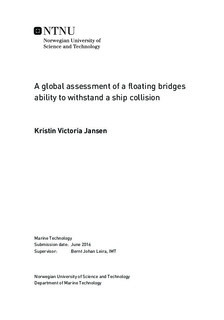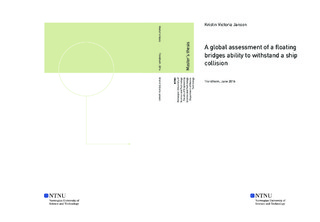| dc.description.abstract | It is planned to exchange the ferry connections along the western coast of Norway with fixed road connections. To be able to do this, new concepts for fjord crossings have to be used. One of these alternatives is a floating bridge, that stands on pontoons to keep it afloat. This is a reason that it will be a good concept as a solution to cross the wide and deep fjords. A bridge of this type will therefore be in the risk of a ship collision.
In this thesis an assessment of the resistance of the pontoons during an impact has been conducted. To do this, the energy absorption and deformations in the bridge was analyzed. To do this nonlinear finite element analysis is required, together with procedures to estimate the energy that will be absorbed.
The first part of the thesis is based on theory. It starts out with describing the concept of floating bridges by going through those that has already been built, before it describes the project "Ferjefri E39" and the basic concepts of a bridge of this type. A closer look is taken at ship collisions, and the standards that exists for collisions, developed numerical methods and risk studies that have been conducted in the field. The last parts of the theory is mainly connected to the finite element method for both a linear and nonlinear approach, with a closer look at the theory for shell and beam elements. In the end of the theory section, the procedure behind an explicit dynamic analysis is described.
The second part of the thesis describes what has been done in the finite element analysis program ABAQUS. This program was selected to conduct the necessary analyses for the the- sis. A model of a floating bridge was designed, and properties were assigned to the model. This model was then used to perform a mesh refinement study on the bridge. A parameter study on the shell thickness and number of bulkheads was also conducted.
The results that are presented are mainly of the structural forces, stresses, moments and energies. These are presented in plots, and are later discussed. The most important results are those connected to the structural integrity of the bridge, and if it will be able to keep afloat without sinking. From the results it could be seen that the shell thickness in the pon- toon was a large factor in the deformation process. A thin walled shell with a thickness of 1 cm would buckle completely, while the pontoon with a shell thickness of 4 cm not would reach yield stress at all. For the study related to the amount of bulkheads, also this had great significance on the results. The difference in maximum stress was large with over a 100 MPa difference. While the model without bulkheads would go into total collapse, the pontoon with many bulkheads kept its integrity. By having very few or no bulkheads at all will not give the pontoon enough stiffness to prevent the vessel from penetrating it. Further, bulkheads have the important role of keeping the entire pontoon from flooding if it gets penetrated. It kan therefore be seen as an important structural element. | |

